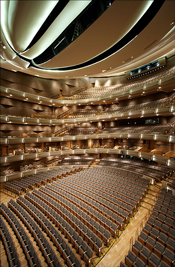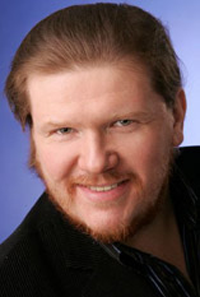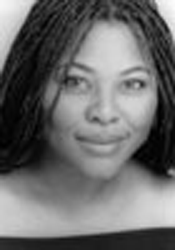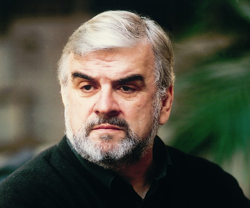
17 Feb 2008
Tosca at COC
An air of anticipation filled the Four Seasons Centre as the announcer walked across the stage to say that soprano Ester Sümegi was ill and would not be performing.
English Touring Opera are delighted to announce a season of lyric monodramas to tour nationally from October to December. The season features music for solo singer and piano by Argento, Britten, Tippett and Shostakovich with a bold and inventive approach to making opera during social distancing.
This tenth of ten Live from London concerts was in fact a recorded live performance from California. It was no less enjoyable for that, and it was also uplifting to learn that this wasn’t in fact the ‘last’ LfL event that we will be able to enjoy, courtesy of VOCES8 and their fellow vocal ensembles (more below …).
Ever since Wigmore Hall announced their superb series of autumn concerts, all streamed live and available free of charge, I’d been looking forward to this song recital by Ian Bostridge and Imogen Cooper.
Although Stile Antico’s programme article for their Live from London recital introduced their selection from the many treasures of the English Renaissance in the context of the theological debates and upheavals of the Tudor and Elizabethan years, their performance was more evocative of private chamber music than of public liturgy.
Evidently, face masks don’t stifle appreciative “Bravo!”s. And, reducing audience numbers doesn’t lower the volume of such acclamations. For, the audience at Wigmore Hall gave soprano Elizabeth Llewellyn and pianist Simon Lepper a greatly deserved warm reception and hearty response following this lunchtime recital of late-Romantic song.
For this week’s Live from London vocal recital we moved from the home of VOCES8, St Anne and St Agnes in the City of London, to Kings Place, where The Sixteen - who have been associate artists at the venue for some time - presented a programme of music and words bound together by the theme of ‘reflection’.
'Such is your divine Disposation that both you excellently understand, and royally entertaine the Exercise of Musicke.’
‘And there was war in heaven: Michael and his angels fought against the dragon; and the dragon fought and his angels, And prevailed not; neither was their place found any more in heaven … that old serpent … Satan, which deceiveth the whole world: he was cast out into the earth, and his angels were cast out with him.’
There was never any doubt that the fifth of the twelve Met Stars Live in Concert broadcasts was going to be a palpably intense and vivid event, as well as a musically stunning and theatrically enervating experience.
‘Love’ was the theme for this Live from London performance by Apollo5. Given the complexity and diversity of that human emotion, and Apollo5’s reputation for versatility and diverse repertoire, ranging from Renaissance choral music to jazz, from contemporary classical works to popular song, it was no surprise that their programme spanned 500 years and several musical styles.
The Academy of St Martin in the Fields have titled their autumn series of eight concerts - which are taking place at 5pm and 7.30pm on two Saturdays each month at their home venue in Trafalgar Square, and being filmed for streaming the following Thursday - ‘re:connect’.
The London Symphony Orchestra opened their Autumn 2020 season with a homage to Oliver Knussen, who died at the age of 66 in July 2018. The programme traced a national musical lineage through the twentieth century, from Britten to Knussen, on to Mark-Anthony Turnage, and entwining the LSO and Rattle too.
With the Live from London digital vocal festival entering the second half of the series, the festival’s host, VOCES8, returned to their home at St Annes and St Agnes in the City of London to present a sequence of ‘Choral Dances’ - vocal music inspired by dance, embracing diverse genres from the Renaissance madrigal to swing jazz.
Just a few unison string wriggles from the opening of Mozart’s overture to Le nozze di Figaro are enough to make any opera-lover perch on the edge of their seat, in excited anticipation of the drama in music to come, so there could be no other curtain-raiser for this Gala Concert at the Royal Opera House, the latest instalment from ‘their House’ to ‘our houses’.
"Before the ending of the day, creator of all things, we pray that, with your accustomed mercy, you may watch over us."
The doors at The Metropolitan Opera will not open to live audiences until 2021 at the earliest, and the likelihood of normal operatic life resuming in cities around the world looks but a distant dream at present. But, while we may not be invited from our homes into the opera house for some time yet, with its free daily screenings of past productions and its pay-per-view Met Stars Live in Concert series, the Met continues to bring opera into our homes.
Music-making at this year’s Grange Festival Opera may have fallen silent in June and July, but the country house and extensive grounds of The Grange provided an ideal setting for a weekend of twelve specially conceived ‘promenade’ performances encompassing music and dance.
There’s a “slide of harmony” and “all the bones leave your body at that moment and you collapse to the floor, it’s so extraordinary.”
“Music for a while, shall all your cares beguile.”
The hum of bees rising from myriad scented blooms; gentle strains of birdsong; the cheerful chatter of picnickers beside a still lake; decorous thwacks of leather on willow; song and music floating through the warm evening air.

An air of anticipation filled the Four Seasons Centre as the announcer walked across the stage to say that soprano Ester Sümegi was ill and would not be performing.
Instead, it would be the Canadian debut of ensemble studio soprano, Yannick-Muriel Noah. Many performers have gotten their “big break” by filling in for a sick colleague and in these situations; the somewhat indecisive role of the “understudy” suddenly becomes something magical. By having the opportunity to show their musical goods, huge international careers have been launched as a result of this very situation. And so, once the announcement was made, Puccini’s Tosca took on quite a different air: one of a fictional tale of real and passionate emotions juxtaposed with the non-fictional reality of a young opera singer making her debut as a fictional opera singer, Floria Tosca.
Puccini’s Tosca is often presented in one of two ways: it can be exciting and exhilarating, leaving one touched at one woman’s unwavering determination, or it can fall flat on its face should its diminutive cast be at all weak in their characterization. This production was a little of both. The one overall aspect that lacked focus was the common Puccinian dichotomy of Eros and Thanatos (Love and Death) which lies at the heart of this work. Cleverly, Puccini imbues the orchestral fabric with wonderfully suggestive moments that indicate this dichotomy, but if Tosca is to be successful, the characters must also inhabit each of these elements at a given point within the opera.
In Tosca, Puccini sews with the thread of religion, a topic that he was not so interested in, except for in his later Suor Angelica. In essence, the religious component in Angelica has nothing to do with religion at all, more than it uses the overall ideal of a religious setting to approach a story about a girl who got herself pregnant out of wedlock. It is a story of sin and redemption in the sense of a woman atoning for sexual urges. Atoning for love, passion, and sex by suffering and death is the concoction that Puccini continually fills into his syringe. With it, he pierces us and tries to teach us the more difficult lessons of living and loving. Tosca functions in an identical manner, however, this production failed to express these elements, for the most part. There were, however, several moments of excellent music making.
 Conductor, Richard Buckley
Conductor, Richard Buckley
The first act began with an elegant sound in the orchestra and a well-chosen tempo by conductor Richard Buckley. He maintained a balanced orchestra fabric, if perhaps it was sometimes lacking in the larger and more dramatic moments where the orchestra is telling of the character’s innermost emotions. The Sacristan, played by Robert Pomakov, was directed in a rather incoherent way, for Puccinian aesthetics. The music of the Sacristan is light-hearted but his religious aura and pious nature are not to be affected. His piety was obscured by Pomakov’s almost spastic, buffo-like actions. Nowhere does Puccini indicate that the sacristan is a comical character. There is an indication in the score that the Sacristan has a “tic” in his neck, but this element of character was dramatically overdone and became somewhat ridiculous. Although Pomokov’s voice is quite lovely, the Italian was unacceptable for a house of this magnitude. There were aspirations of all sorts, where the authentic Italian language does not consist of these aspirations in consonants but is softer and rounder. Doubled-consonants are stopped with the tongue to create the proper affect and unfortunately Pomakov’s Italian was much too Americanized to pass for authenticity.
The set was quite lovely and spacious: on the left, the portrait of the Contessa Attavanti, and on the right an altar to the Madonna. The orchestral tempi were well chosen and the orchestra’s beautiful playing certainly overshadowed the inconsistent dramatic purpose of the Sacristan in the opening. Cavaradossi’s entrance was cavalier as tenor Mikhail Agafanov filled the stage with a handsome and testosterone-filled presence. The orchestral horns were brilliant at this moment and set the stage for the pure tenore affogato sound that is expected of Puccinian singing.
 Tenor, Mikhail Agavonov
Tenor, Mikhail Agavonov
Although Agafonov has a tremendous upper tessitura, his singing was often not as legato as Puccinian aesthetics require. In his letters and the journals of singers with whom he coached, Puccini indicated that the legato line was to be carried “not from note to note, as in Mozart, but carried through every note in between the notes he had written on the page.” Simply, that means that his music requires an influx of portamenti, graceful sliding from note to note, which were not successfully applied to this production in its entirety. It was sung in a very strict manner, unfortunately, where the application of legato sul fiato (singing on the breath) means a very different thing for Puccini.
The woodwinds were precise in their entry to Cavaradossi’s first aria, “Recondita Armonia,” which was rather disappointing. For some reason, Mr. Agavonov seemed to sing more effectively during passages of Cantilena or Arioso rather than in a full-blown aria. This aria is where the first flickering of Cavaradossi’s passion begins to spark, its ultimate purpose being to cause the audience to fall in love with him, so that we may further relate to Tosca. Unfortunately, Agavonov’s expression failed to ignite the audience. The arias in Puccini should be sung with a completely spinning line and very little straightening of that sound, as in pure Bel Canto singing, however, this was not the case for Agavonov. It is a lovely sound but tends to lose in the middle and lower tessitura because of his straightened tones. These, on several occasions, even caused him to sing under the pitch. The orchestra, however, was excellent.
The acting was mediocre at best, where Puccini’s works are meant to represent “realism” in its most definitive operatic ideal. The acting should always be larger-than-life, but here it lacked in energy and spontaneity. Tosca’s anticipated entrance was a glimmer of hope to save things and Ms. Noah entered with an air of authority, although her first vocal entry showed a great deal of nervousness. It is a large and powerful voice with a blood-red colour and golden hues in the upper tessitura. Ms. Noah’s nerves got the best of her in the first act, which was not surprising. The orchestra began to emerge more readily, as Puccini demands at Tosca’s entry and was aesthetically excellent. Praises go to Maestro Buckley for his control and precise handling of the delicate music.
 Soprano, Yannick-Muriel Noah
Soprano, Yannick-Muriel Noah
Ms. Noah’s acting also was sporadic and the necessary spark that was supposed to ignite a passion worth dying for, between Tosca and Cavarodossi, would never occur. Unfortunately, Ms. Noah’s nerves and the lack of intimacy between the two singers caused the first act to be inconsistent and quite boring. The tremendous quality of Ms. Noah’s voice is unquestionable, but she is perhaps too young yet to sing a Tosca. She had some difficulty in the upper tessitura in the first act and parts of the second, where Tosca is a role that requires a grand maturity a completely solid upper tessitura. She deserves respect, however, for having the guts to perform it in a house of this magnitude and give it her best.
Once she got going, Ms. Noah’s voice exhibited beautiful timbres and she showed us that she possesses a tremendous upper voice, which she eloquently displayed in the second Act where she was much more comfortable and settled. Unfortunately, she did not define Tosca’s jealousy sufficiently, especially in singing of the important words of Tosca’s jealousy “Quei occhi.” There was simply not enough emphasis on this text and really, it was almost inaudible. The interchange between Tosca and Cavaradossi was not very interesting and Agavonov was flat in several instances here. He sang excellently, however, the words “Floria, T’Amo”…if he had sung everything as he did this line, the entire mood of the presentation might have been different. In addition, had there been a good stage kiss, perhaps a more erotic mood might have prevailed; one that is necessary for any Puccinian opera, where human passions are at their most extreme. Because this opera has a very small cast, the necessity of that kiss is imperative to the personal relationship between Tosca and Mario. There was not even a touching of lips.
Andrew Stewart, who played the prisoner, Angelotti, had good stage presence but his diction was completely inaudible and unfortunately continued to show a lack of consistency in this production. The chorus, however, was the brimming light of this production and praises go to Sandra Horst for her direction and attention to detail. The chorus had the most authentic Italian sound in this production, and were wonderfully unified whole. Bravi!!!
 Baritone, Alan Opie
Baritone, Alan Opie
At the end of Act 1, Alan Opie’s entrance, as Scarpia, was a little thin in the orchestral texture. Maestro Buckley could have let it rip a little more, especially with those luscious and most descriptive harmonic chords. Mr. Opie’s Italian was better than his colleagues’ and this along with his more consummate acting abilities were enough to change the direction of the production up to this point. His baritone was quite lovely, if a bit thin for a Scarpia, and a little weak in the upper tessitura.
The Te Deum, of course, was the highlight of the first act with a full processional in complete religious attire. The children of the chorus were delightful. The addition of the organ and tubular bells gave a majestic aura of supreme grandiosity. It was fantastically done. The drama was created simply by the direction of the chorus, with three prostrate priests lying down as if attaining their ordination and the grandeur and majesty of the procession. The Te Deum is the catalyst that moves the more religious first act into the sinful, painful torture of Cavaradossi , and the attempted rape of Tosca. Act 1 is Eros.
Act 2 is Thanatos (Death). It began with strong dramatic intensity, with Scarpia lovingly caressing the letter opener that would soon be the cause of his death. Again, the orchestra looms the dichotomy of love and death . If the first act is love, then the second act is death and Puccini’s sadistic penchant becomes the focus of the act. The low Brass in the orchestra shone forth in this instance with some exquisite playing while intoning a foretelling funeralistic dirge.
Ms. Noah’s performance of Tosca’s “Cantata,” (sung offstage) was quite lovely and it was obvious that she was going to be “different” in this act. La Scena degli strazzi (the torture scene) with Cavaradossi being battered for information was rather fake in its drama. The scene has to be more realistic for it to work and this was an example where it unfortunately failed. The opening of the secret vault leading to a more effective torture chamber was quite brilliant and the addition of Puccini’s dissonances began the crescendo of drama that would end in Scarpia’s murder.
Finally, Ms. Noah seemed to engulf herself in Tosca’s character and her upper tessitura opened significantly. The power of this voice is quite tremendous; however, the drama required her to be more defiant in her character. She seemed more sporadic and pacing than defiant. She could have been more hateful in throwing piercing words at Scarpia, like “Assassino!” The decisive moment at the text “Il Prezzo,” where Tosca asks the cost of Mario’s freedom required more space. Tosca already knows the cost but for this scene to work, as Puccini dramatically set it, the momentum between the torture scene and the instance of this question has to be maintained.
When Scarpia finally attacks Tosca, the acting was powerful with Mr. Opie throwing her down on the coach while pressing himself on top of her. That he exposed a good deal of flesh by lifting her dress was appropriate here. There are no holds barred with Puccini and he would have rightfully approved of this type of stage direction. Had the entire opera possessed this kind of realistic drama and erotic intensity, the production as a whole would have been more successful.
Tosca crawls along the floor to escape Scarpia’s clutches and ends at a chair on her knees to sing her famous “Vissi D’Arte.” Ms. Noah sang it rather strictly and without the necessary Puccinian punto di linea that the composer indicated to sopranos like Maria Jeritza. Several moments within the aria required more attention to diction, such as the missing doubled-consonants. It was a little rushed, but it was apparent that Ms. Noah took it at a safe and moving tempo. In effect, Ms. Noah exhibited her voice more potently here and she really gave it to her audience as much as possible. The audience broke out in a roar of support and encouragement for her, as if to say, “Keep singing and we will support you.”
Scarpia’s murder was quite realistic and Ms. Noah chose to use an affective chest-voice to utter the affectionate words “muori dannato,” (die in damnation)! Even moreso, she spoke the words “D’avanti à lui tremava tutta Roma” (In front of him all of Rome trembled) with great hatred; although, to be even more affective she might have taken more time here and really rolled out the “r” in the word “tremava” as if to add some reality to the word, tremble.
The set for Act III was interesting, with the top of the Castel Sant’Angelo exposed as a large cistern in which Tosca would plummet to her eventual death. The mood created by the set, lighting, and orchestra was quite powerful, but when Agafonov sang “E lucevan le Stelle,” the mood was broken. This aria was the poorest of the evening with several inconsistencies between the orchestra and Agavonov. In an aria that usually stops the show, there wasn’t one morsel of applause and the show continued on toward the end. Mr. Agavonov’s upper range is quite impressive but his middle was lacking intensity in the aria. His burnished colour was appropriate but he lacked the necessary slancio that this particular aria requires. The orchestra, however, was supportive and the woodwinds gave the essence of a spectacular heart-wrenching moment, but Mr. Agavonov did not take on their motive well.
The finale brought a powerful dramatic climax with the firing of the gun-squad and the ‘supposed’ fake-death of Mario. Ms. Noah’s reaction to his death was vocally secure, but dramatically thin. Her despair needed to follow her up those steps to the roof of the Castel Sant’Angelo and in final vengeance utter her final words, “O Scarpia, avanti a Dio!” (In front of God, Scarpia!).
Although the production was not outstanding, the house itself is acoustically wonderful and the orchestra was superb in their delivery, interest in the drama, and depth of colour. Tosca is a difficult opera, in that it rests securely on the merits of the two lead roles. Whatever weakness the singers possess, will result in the characters’ weakness. A good attempt by two very fine voices but, as a whole, the lack of distinct Puccinian aesthetics applied to this performance and the need for a just more raw and erotic relationship between Mario and Tosca caused it to be less than spectacular.
Mary-Lou P. Vetere
PhD (ABD), M.A., Mus.B